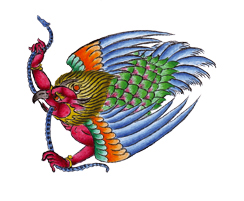Garuda: Difference between revisions
Jump to navigation
Jump to search
| Line 13: | Line 13: | ||
===One of the Four Dignities=== | ===One of the Four Dignities=== | ||
The Garuda is also one of the [[four dignities]] associated with the [[windhorse]]. In this | The Garuda is also one of the [[four dignities]] associated with the [[windhorse]]. In this context, the garuda represents the fire element, and it is said to to symbolize freedom from hopes and fears. | ||
===Deity of Projection=== | ===Deity of Projection=== | ||
Revision as of 10:46, 27 August 2008

Garuda (Tib. khyung) – a mythical bird-like creature that symbolizes various aspects of the Buddhist path.
Overview
The Garuda symbol can have the following meanings:
- A mythical Tibetan creature
- One of the four dignities associated with the windhorse
- A deity of protection
- Our primordial nature
A Mythical Creature
On the outer level, the Garuda is a mythical bird-like creature that is the enemy of the nagas.
One of the Four Dignities
The Garuda is also one of the four dignities associated with the windhorse. In this context, the garuda represents the fire element, and it is said to to symbolize freedom from hopes and fears.
Deity of Projection
The Garuda is also an important deity of protection. For example:
- It is one of the Three Deities of the Great Master Vajrapani
- It is depicted above Vajrakilaya in Vajrakilaya thankas
- The practice of Takhyung Barwa combines the practices of Hayagriva, Guru Drakpo, and Garuda.
Our Primordial Nature
In the Dzogchen teachings, the Garuda represents our primodial nature. The Tibetan Book of Living and Dying says:
- The Dzogchen Tantras, the ancient teachings from which the bardo instructions come, speak of a mythical bird, the garuda, which is born fully grown. This image symbolizes our primordial nature, which is already completely perfect. The garuda chick has all its wing feathers fully developed inside the egg, but it cannot fly before it hatches. Only at the moment when the shell cracks open can it burst out and soar into the sky. Similarly, the masters tell us, the qualities of buddhahood are veiled by the body, and as soon as the body is discarded, they will be radiantly displayed. [1]
Notes
- ↑ The Tibetan Book of Living and Dying, page 109.